Motion Control footwear 2009
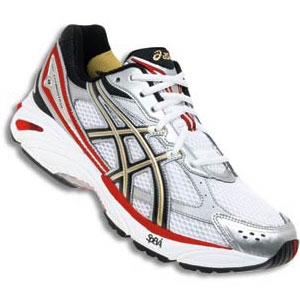
[Editor’s note: Slowtwitch has several editors-at-large for footwear, including: Jeroen van Geelen who owns Total Running, one of the more important running and triathlon retail establishments in The Netherlands; Pete Beauregard and Doug Smiley, both principals at City Sports, a chain of 15 specialty footwear stores along the Eastern Seaboard.]
While not often the go-to shoe on race day for triathletes, motion control shoes serve a purpose for the right runner: to keep the foot in proper alignment throughout the gait cycle by preventing severe overpronation. While they'll never be confused with a racing flat, motion control shoes do resemble most trainers, but with a few distinct features.
Motion control shoes are intended for flat-footed runners, and aid them by preventing overpronation. To achieve this, motion control shoes (often abbreviated “MC” in the shoe's description) are built on a wider last. This makes the shoes orthotic-friendly, as well as accommodating a wider foot by providing more volume throughout.
Along with a wider last, and while every running shoe vendor uses different technologies, motion control shoes provide maximum support on the medial side of the shoe.
While there is currently not a tri-specific motion control shoe on the market, they are nevertheless essential training tools for many runners. Finding the correct shoe for your foot type and gait is fundamental to running efficiently and preventing injury, so make sure to visit your trusted local running specialty shop and have your form analyzed by one of its trained staff.
If a motion control shoe is what you need, you'll find great styles on the market from several footwear vendors. Below is a quick rundown of each vendor's key models.
Asics
Gel Foundation 8
Weighing in at 12.8oz (men's 9) And featuring a sleeked down silhouette, the Gel Foundation 8 (pictured above) isn't as built-up as some of the other styles in this review, It nonetheless provides superior medial support for severe overpronators. The Foundation 8 was crowned "best update" in the Runners World Summer 2008 Shoe Guide, and delivers on its promise of being a maximum support shoe in a minimalist package.
If you've worn Asics in the past, the fit and try-on feel of the Foundation 8 should feel quite similar. The heel is fairly snug and is lined with Asics' PHF (Personalized Heel Fit) memory foam—a huge plus if heel slippage is an issue. True to its reputation for attention to detail, Asics makes its shoes on width-specific lasts, so the PHF heel will cradle the foot different on a men's D width than it will on a men's 4C width.
By locking down the heel so securely, Asics was able to eliminate much of the overlay and support across the upper of the shoe, thereby lessening the chance of any hot-spots or irritation from an overly supportive upper. This expanded volume throughout the midfoot and upper proves valuable if you're using your own orthotics, which don't always fit perfectly into your new shoe.
Along with a secure heel fit and minimalist upper, the gel-cushioning crash pads in the heel and forefoot give the foundation a resilient try-on feel, and prove ultra-responsive on longer runs—a very important feature for runners looking to soften the ride on their runs or who tend to hit the pavement harder than most.
The main support features of the Gel Foundation 8 are two: First is the Trusstic system that extends through the mid-foot and acts as a "bridge" between the heel and forefoot. Along with providing the Foundation 8 with structural integrity and aiding the foot through the load phase, the Trusstic system eliminates weight by sculpting out any unnecessary materials.
Working in conjunction with the Trusstic system is a Duomax support system. The Duomax is a dual-density midsole component that slows the degree and velocity of pronation, giving over-pronators solid support where they need it most.
The Gel Foundation 8 isn't a radical departure from Asics' well-known stability linchpins, the Kayano and 2100 series. Rather, it's the next degree of support if you love the fit and feel of Asics, but need medial support.
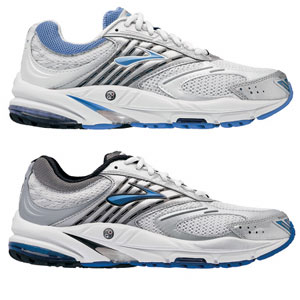
Brooks
Ariel/Beast
In a world of running shoes striving for minimalism and reduced weight, the Ariel/Beast (pictured adjacent, Ariel on top Beast underneath), stands apart for its eternal theme: deliver a shoe with most support possible, end of discussion. When it comes to the Ariel (women's version) and the Beast (men's), it's usually a yes or no question: Do you or don't you need it? For any runner who answers “yes,” the Beast has been his salvation.
At 14oz on the men's side and 12.3oz on the women's, the Ariel/Beast does not skimp on support or cushioning. The plush first-feel and long-term durability comes courtesy of a Mogo midsole, which has replaced S-257 in last few years as Brooks' primary midsole material and boasts double-digit increases in cushioning, energy return and fatigue resistance.
The main support feature of the Ariel/Beast is Brooks' Progressive Diagonal Rollbar (PDRB), a dual-density posting system biomechanically engineered to provide progressive pronation control and offering a smoother transition from mid-stance to propulsion. So instead of a runner feeling like he’s hit a wall in the middle of his gait cycle, the Ariel/Beast gradually starts slowing the rate of pronation upon heel strike on a graduated basis—offering only as much support as needed, thereby providing a more natural foot motion.
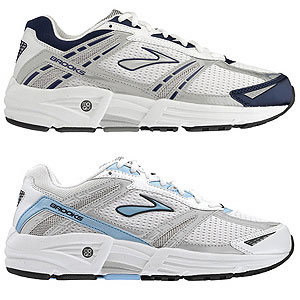
Addiction
Relative to the uber-supportive Ariel/Beast (pictured adjacent, men’s version on top, women’s underneath), the addiction might seem a bit like motion control light—at first glance. However, the Addiction has managed to cultivate its own following of running loyalists after eight renditions and continued enhancement of key support and cushioning technologies.
Like the Ariel/Beast, the Addiction is built on Brooks' Linear Platform, its straightest last, which provides the most volume throughout, and provides an orthotic-friendly fit for many a runner.
While the Ariel/Beast is hard on the scale, the Addiction registers in at a relatively svelte 12.9oz for men and 10.7oz, putting it close to par with the Gel Foundation. Also similar to the Foundation is the Addiction's unintrusive upper geometry—plenty of wide-open airmesh, no unnecessary overlays, and an internal midfoot saddle for lockdown support.
And like the Ariel/Beast, the primary cushioning (full-length Mogo midsole) and support (PDRB) are the same. However, the Addiction features Brooks' engineered MC pod configuration in the midsole and outsole. The Addiction's pod configuration is configured to set the foot in alignment and balance throughout the gait cycle, offering support, control and flexibility from heel strike to toe-off. If you're a severe overpronator sold on the fit, feel and support Brooks offers but are looking for something lighter and more flexible than the Ariel/Beast, then look no further than the Addiction.
[If you like what Doug has written, most of these shoes can be purchased at his click and mortar store: City Sports. Slowtwitchers can get a 10 percent discount on their entire City Sports orders by typing slowtwitch into the promo code box.]


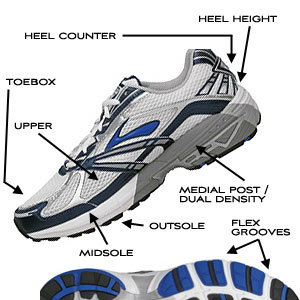
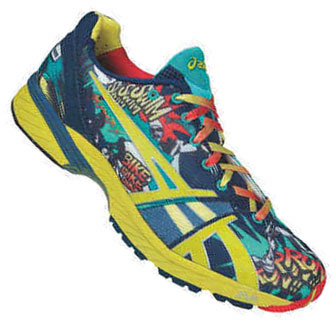
Start the discussion at slowtwitch.northend.network